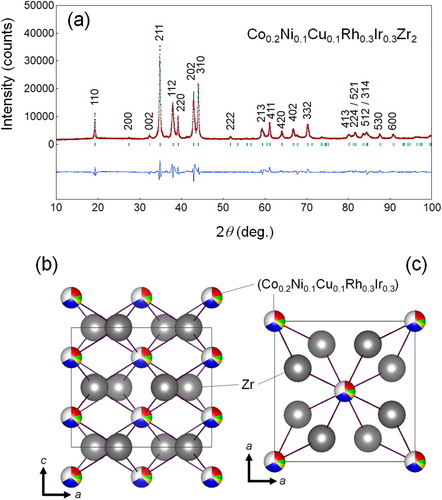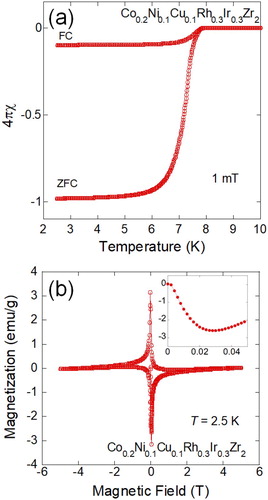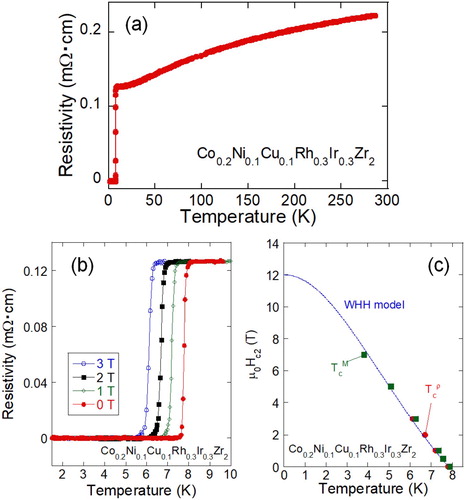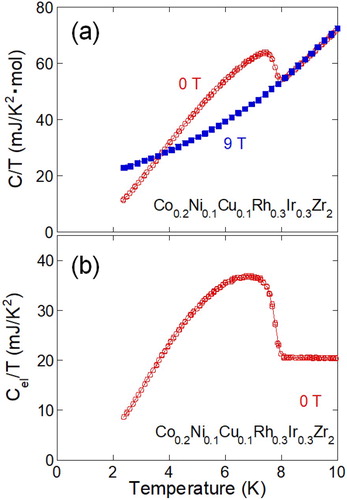ABSTRACT
Research on high-entropy-alloy (HEA) superconductors is a growing field in material science. In this study, we explored new HEA-type superconductors and discovered a CuAl2-type superconductor Co0.2Ni0.1Cu0.1Rh0.3Ir0.3Zr2 with a HEA-type transition metal site. A superconducting transition was observed at 8.0 K after electrical resistivity, magnetization, and specific heat measurements. The bulk characteristics of the superconductivity were confirmed through the specific heat measurements. The discovery of superconductivity in HEA-type Co0.2Ni0.1Cu0.1Rh0.3Ir0.3Zr2 will provide a novel pathway to explore new HEA-type superconductors and investigate the relationship between the mixing entropy and superconductivity of HEA-type compounds.
GRAPHICAL ABSTRACT

IMPACT STATEMENT
We report on the material design, synthesis, and observation of a superconducting transition at 8.0 K in new high-entropy-alloy-type compound with a CuAl2-type structure, Co0.2Ni0.1Cu0.1Rh0.3Ir0.3Zr2.
1. Introduction
Recently, high-entropy alloys (HEAs) [Citation1,Citation2], which are defined as alloys containing five or more elements with a concentration between 5 to 35at%, have been extensively studied in the fields of material science, engineering, chemistry, and physics. Alloys synthesized to fit the criterion result in high configurational mixing entropy (ΔSmix), which is defined as ΔSmix = -R Σi ci ln ci, where ci and R are the compositional ratio and the gas constant, respectively [Citation2]. In a HEA, five or more mixed elements are sometimes distributed randomly, and mixing elements sometimes results in the formation of nanoscale phase separations [Citation3,Citation4]. Such unique structural characteristics of HEAs have fascinated researchers in the field of superconductivity because nanoscale structural and/or electronic disorders could be useful for improving critical current density in some cases [Citation5–7]. Recently, the exploration and investigation of HEA superconductors has been a hot topic since the discovery of the first HEA superconductor Ta34Nb33Hf8Zr15Ti11 in 2014 with a transition temperature Tc = 7.3 K [Citation8,Citation9]. After the discovery, various HEA superconductors with a simple alloy-type structure (bcc and hcp structures) have been discovered [Citation9–15]. Although the pairing mechanisms of superconductivity in these HEA superconductors have been characterized as a conventional type, the field has been getting attention because HEA superconductors possess exotic characteristics. For example, electrical resistance measurements under extremely high pressures revealed that the superconductivity states in Ta-Nb-Hf-Zr-Ti are robust under pressures up to 190 GPa [Citation16]. This fact suggests that the HEA states may be useful for maintaining the essential crystal structure and electronic states for the emergence of superconductivity under extreme conditions. In addition, as mentioned above, the concept of HEAs should be useful for research on improving the critical current density (Jc) of superconductors for practical use. Therefore, we need to extend the concept of HEAs to various compounds other than bcc and hcp metals to develop the field of HEA-type superconductors.
In 2018, Stolze et al. reported superconductivity in CsCl-type (Sc,Zr,Nb,Ta)0.65(Rh,Pd)0.35 [Citation17]. Because a CsCl-type structure is composed of two different crystallographic sites, the (Sc,Zr,Nb,Ta)0.65(Rh,Pd)0.35 superconductor can be regarded as a HEA-type compound. Recently, we reported the synthesis and superconducting properties of HEA-type layered superconductors [Citation18,Citation19]. In a BiS2-based layered superconductor system (REO0.5F0.5BiS2: RE = La, Ce, Pr, Nd, Sm), an increase in ΔSmix improved the superconducting properties, owing to the suppression of local structural disorder [Citation20,Citation21]. Single crystal growth and the superconducting properties of HEA-type RE(O,F)BiS2 have also been reported; superconducting properties comparable to low-entropy systems were confirmed [Citation22]. In a RE123-type cuprate system with RE = Y, La, Pr, Nd, Sm, Eu, Gd, no degradation of Tc after an increase in ΔSmix was confirmed [Citation19]. Therefore, the HEA effects in layered superconductors seem to be working positively or at least less effectively. Recently, superconductivity in NaCl-type tellurides and related chalcogenides have been reported [Citation23–25]. For example, a HEA-type telluride AgInSnPbBiTe5 contains an HEA-type M site (M = Ag, In, Sn, Pb, Bi) and a Te site and exhibits superconductivity with Tc = 2.6 K. In contrast to the layered systems, the superconducting properties of NaCl-type HEA tellurides are lower than those of low-entropy tellurides [Citation24]. These results imply that the crystal structure type and its dimensionality are related to the effects of high-entropy alloying on the superconducting properties of compounds.
We explored a new HEA-type compound in this study. We have focused on the CuAl2-type (I4/mcm) structure because over 100 superconductors could be found in a superconductor database (SuperCon, NIMS database) [Citation26]. Among them, RhZr2 has the highest Tc of 11.3 K [Citation27]. Furthermore, as summarized in Table I, all of the TrZr2 (Tr = Co, Ni, Rh, Ir) compounds exhibit superconductivity with Tc = 5.5, 1.6, 11.3, and 7.5 K, respectively [Citation27]. Although FeZr2 is a superconductor, its Tc is lower than 1 K [Citation28,Citation29]. In the case of Tr = Cu, CuZr2 has a CuZr2-type (I4/mmm) structure, but partial substitution of Cu for the CuAl2-type compounds is possible and positively affects Tc. In Co1-xCuxZr2, the Tcs for x = 0.05 and 0.1 are higher than those for x = 0 [Citation30]. According to the Tc and the crystal structure of the TrZr2 compounds, we have designed a new HEA-type compound Co0.2Ni0.1Cu0.1Rh0.3Ir0.3Zr2, in which the composition at the Tr site meets the compositional criterion of the HEA and achieves ΔSmix ∼ 1.5R for the Tr site.
Table 1. Crystal structure type, space group, and Tc of TrZr2 and related phases (Tr = Co, Ni, Cu, Rh, Ir).
2. Methods
A polycrystalline sample of Co0.2Ni0.1Cu0.1Rh0.3Ir0.3Zr2 was synthesized through arc melting in an Ar atmosphere. Powders of pure metals, Co (99%), Ni (99.9%), Cu (99.9%), Rh (99.9%), and Ir (99.9%), were mixed with a certain composition and pelletized. The metal pellet and a plate of pure Zr (99.2%) were used as starting materials for arc melting. The arc-melting was repeated after turning over the sample three times to homogenize the sample. The obtained sample was characterized using energy dispersive X-ray fluorescence analysis on a JSX-1000S (JEOL). The phase purity and crystal structure were examined through X-ray diffraction (XRD) with Cu-Kα radiation on a Miniflex-600 (RIGAKU) equipped with a high-resolution semiconductor detector D/tex-Ultra. The obtained XRD pattern was refined by the Rietveld method using RIETAN-FP [Citation31], and schematic images of the refined crystal structure were depicted using VESTA [Citation32]. Magnetization was measured using a superconducting quantum interference device (SQUID) on an MPMS-3 (Quantum Design). The temperature dependence of magnetization was measured after zero-field cooling (ZFC) and field cooling (FC). The susceptibility data shown in Figure was corrected using a demagnetization factor. Meanwhile, the magnetic field dependence of magnetization was measured from -7 to 7 T. The temperature dependence of electrical resistivity under magnetic fields up to 3 T was measured using a four-terminal method with a DC current of 5 mA on a GM refrigerator system (AXIS). The temperature dependence of specific heat was measured using a relaxation method on PPMS (Quantum Design) under 0 and 9 T.
3. Results and discussion
Herein, we report the discovery of a HEA-type superconductor Co0.2Ni0.1Cu0.1Rh0.3Ir0.3Zr2 with Tc = 8 K, at which the onset of the superconducting transition was observed in the temperature dependences of magnetization, electrical resistivity, and specific heat. The sample obtained through arc melting was silver-colored. The calculated sample-weight loss during the pelletizing and arc-melting processes was less than 1%; the obtained sample weighed 1.1167 g. The measured composition of the sample was Co0.187Ni0.097Cu0.083Rh0.328Ir0.305Zr2, which was calculated by fixing the Zr amount to 2. Although a slight deviation of the measured composition from the nominal starting composition was observed, the measured composition was close to the nominal value. Therefore, we called the sample Co0.2Ni0.1Cu0.1Rh0.3Ir0.3Zr2 using the nominal value in this paper. Note that all the transition metal compositions are in the range of 5–35%, which meets one of the criteria of the HEA. The calculated ΔSmix for the Tr site was 1.47R. As shown in Fig. S1 (supplemental data), the homogeneous distribution of Tr elements was confirmed through elemental mapping, suggesting no local phase separation in the order of μm.
Figure (a) shows the powder XRD pattern and the Rietveld refinement results. There is no clear indication of the presence of impure phases. Refinement with a tetragonal CuAl2-type (I4/mcm) model resulted in a reliability factor of Rwp = 8.7%. The refined lattice constants were a = 6.5006(2) Å and c = 5.5320(3) Å. The atomic coordinates were Zr(x, y, z) = (0.1639(3), 0.6659(3), 0) and T(x, y, z) = (0, 0, 0.25). Schematic images of the refined crystal structure are shown in Figure (b,c).
Figure 1. (a) XRD pattern and Rietveld fitting for Co0.2Ni0.1Cu0.1Rh0.3Ir0.3Zr2. The numbers in the figure are Miller indices. (b, c) Schematic images of crystal structure of CuAl2-type Co0.2Ni0.1Cu0.1Rh0.3Ir0.3Zr2.

Figure 2. (a) Temperature dependence of (ZFC and FC) susceptibility (4πχ) for Co0.2Ni0.1Cu0.1Rh0.3Ir0.3Zr2. (b) Magnetic field dependence of magnetization for Co0.2Ni0.1Cu0.1Rh0.3Ir0.3Zr2 taken at T = 2.5 K. The inset shows low-field M-H data.

Figure (a) displays the temperature dependence of the susceptibility (4πχ) for Co0.2Ni0.1Cu0.1Rh0.3Ir0.3Zr2. Large diamagnetic signals, corresponding to the emergence of superconductivity, were observed below 7.8 K. Susceptibility below 300 K is shown in Fig. S2(a) in the Supplemental Data, which exhibits no clear magnetic transition below 300 K. Figure (b) displays the magnetic field dependence of magnetization (M-H) at 2.5 K. It is evident from the data that superconducting currents are generated. The magnetic Jc estimated from M-H is displayed in Fig. S2 (Supplemental Data). When comparing the data with that for CoZr2 (Tc ∼ 6 K for our sample), we note that Jc at low magnetic fields is comparable between them, but Jc for Co0.2Ni0.1Cu0.1Rh0.3Ir0.3Zr2 at higher fields is higher than CoZr2. To further analyze the effect of the introduction of a HEA site to TrZr2 and related systems, experiments using single crystals are needed. The inset figure shows an M-H plot at low fields, which confirms that the lower critical field (μ0Hc1) is ∼ 20 mT. From these magnetization data, we confirmed that Co0.2Ni0.1Cu0.1Rh0.3Ir0.3Zr2 is a typical type-II superconductor.
Figure (a) shows the temperature dependence of the electrical resistivity (ρ) for Co0.2Ni0.1Cu0.1Rh0.3Ir0.3Zr2. Typical metallic behavior was observed, which is consistent with previous reports on TrZr2 compounds [Citation27,Citation33]. As shown in Figure (b), the onset temperature (Tconset) and the zero-resistivity temperature (Tczero) were 8.0 and 7.5 K, respectively, at 0 T. Tc decreased with increasing magnetic field [Figure (b)]. To estimate the upper critical field at 0 K [μ0Hc2(0)], the resistive midpoint Tc (Tcρ) and magnetic TcM estimated from magnetization under various magnetic fields (see supplemental data, Fig. S3) are plotted in a magnetic field-temperature phase diagram in Figure (c). Using the WHH model (Werthamer-Helfand-Hohenberg model) [Citation34], which is applicable for a dirty-limit type-II superconductor, the μ0Hc2(0) was estimated as 12 T.
Figure 3. (a) Temperature dependences of electrical resistivity for Co0.2Ni0.1Cu0.1Rh0.3Ir0.3Zr2. (b) Temperature dependences of resistivity for Co0.2Ni0.1Cu0.1Rh0.3Ir0.3Zr2 under magnetic fields. (c) Magnetic field-temperature phase diagram for Co0.2Ni0.1Cu0.1Rh0.3Ir0.3Zr2.

To confirm the bulk nature of the observed superconductivity, the specific heat was measured on a small piece (4.384 mg) of Co0.2Ni0.1Cu0.1Rh0.3Ir0.3Zr2. Figure (a) shows the temperature dependence of specific heat under 0 and 9 T. A clear jump was observed below 8.0 K under 0 T, but no superconducting transition was observed at 9 T. Therefore, we used the data under 9 T to estimate the electronic specific heat coefficient (γ) and the coefficient for the lattice specific heat contribution (β). The estimated γ and β were 20.7 mJ/mol·K2 and 0.519 mJ/mol·K4, respectively The Debye temperature (θD) was estimated to be 224 K, which is close to that reported for a CoZr2 single crystal [Citation33]. To characterize the superconducting properties, the electronic contribution (Cel) at 0 T, which was calculated using Cel = C – βT3, is plotted in the form of Cel/T as a function of temperature in Figure (b). The clear jump of Cel/T and decrease in Cel/T at low temperatures suggest bulk nature of the observed superconducting transition. However, the superconducting transition seen from Cel was relatively broad compared to single crsytal data for CoZr2 [Citation33]. The origin of the broad transition is not clear, but the present data are sufficient to confirm the emergence of bulk superconductivity in the examined sample. The superconducting jump in Cel (ΔCel) estimated at Tc = 7.4 K is 1.12γTc (see supplemental data Fig. S4), which is smaller than the value expected from the BCS model [Citation35]. The smaller jump and the nature of the broad transition may imply the possibility of the semi-continuous evolution of the superconducting gap caused by HEA effects and/or the unconventional nature of the superconducing gap. To obtain further information about superconducting characteristics, specfic heat experiments at lower temperatures, scanning tunneling microscopy (STM), and angle-resolved photoemission spectroscopy (ARPES) are needed.
Figure 4. (a) Temperature dependence of C/T for Co0.2Ni0.1Cu0.1Rh0.3Ir0.3Zr2 at 0 and 9 T. (b) Temperature dependence of electronic specific heat Cel/T at 0 T.

To discuss the effects of the HEA states at the Tr site of TrZr2 on the superconducting properties, we compared the Tcs of pure TrZr2 and Co0.2Ni0.1Cu0.1Rh0.3Ir0.3Zr2. In known HEAs, properties or performances are sometimes close to the average of all the constituent metals. However, they sometimes result in unexpectedly high or low values [Citation17], which is called the cocktail effect. In the case of Tc of Co0.2Ni0.1Cu0.1Rh0.3Ir0.3Zr2, Tc = 8.0 K appears to be close to the composition-weighted average value of Tcs for Tr = Co, Ni, Rh, Ir. Therefore, a cocktail effect-like improvement of Tc was not found in the present study. However, the averaging effect on Tc is interesting from the electronic-state point of view. The electronic states of CoZr2 were reported in Ref. 33. The density of states near the Fermi energy (EF) is mainly composed of contributions of Co-d and Zr-d electrons. In addition, we compared the density of states near EF for Tr = Co, Ni, Rh, Ir using the CompES-X, NIMS database [Citation36]. Although the Zr-d contributions become higher for Tr = Rh, Ir, the Tr-d and Zr-d contributions are essential for the density of states near EF. Therefore, the disorder at the Tr site does not directly suppress Tc in this system, and we propose that the HEA-type TrZr2 system is suitable for discussing the effects of HEA site in superconductors.
Here, we briefly describe the future prospects of the HEA-type TrZr2 compounds. First, we expect that we can flexibly design various kinds of HEA-type TrZr2 according to the elemental and compositional design described in the introduction part of this paper. In a superconductor database [Citation26], TrZr2-type superconductors containing Tr = Sc, Fe, Co, Ni, Cu, Ga, Rh, Pd, Ta, Ir can be found. Therefore, the TrZr2 phases with a HEA-type Tr site will be useful for discussing the effects of long-range disorder, local phase separation, and/or modulation of local structure on superconducting properties. Furthermore, clarification of the HEA effects in superconductors will be important for the improvement of practical superconducting materials. Another possible merit of the HEA-type TrZr2 is the congruent melting character of the TrZr2 phases. As reported in Ref. 33, high-quality single crystals can be obtained through a simple crystal growth. Therefore, the HEA-type TrZr2 phases will provide us with a platform to study the relationship between the superconducting properties and HEA states using single crystals.
4. Conclusion
We have reported the synthesis and superconducting properties of a new HEA-type superconductor Co0.2Ni0.1Cu0.1Rh0.3Ir0.3Zr2 with a HEA-type Tr site. The composition of Co0.2Ni0.1Cu0.1Rh0.3Ir0.3Zr2 was designed based on information of the crystal structure (CuAl2-type) and Tc of the TrZr2 compounds from the NIMS database (SuperCon). A polycrystalline sample was prepared using pure metals through arc melting. A superconducting transition was observed at 8.0 K in magnetization, electrical resistivity, and specific heat measurements. From the magnetization and resistivity data under magnetic fields, the upper critical field μ0Hc2(0) was estimated as 12 T. Specific heat data suggests that the superconductivity observed in the sample is bulk in nature. The estimated electronic specific heat coefficient and the Debye temperature were close to those reported for a CoZr2 single crystal. Although a cocktail effect, which is an unexpected (non-average) improvements of the performance, was not observed on the Tc of Co0.2Ni0.1Cu0.1Rh0.3Ir0.3Zr2, the discovery of superconductivity in HEA-type TrZr2 should open up new avenues to explore novel HEA-type supercondcutors and investigations on the relationship between the mixing entropy, local structure, and superconductivity in HEA-type compounds.
Acknowledgements
The authors thank R. Tsubota, N. Nakamura, A. Yamashita, and O. Miura for their assistance with the experiments. This work was partly supported by JSPS KAKENHI [Grant Number: 18KK0076] and the Advanced Research Program under the Human Resources Funds of Tokyo [Grant Number: H31-1].
Disclosure statement
Experimental data are available via reasonable requests to the corresponding author. No potential conflict of interest was reported by the author(s).
Additional information
Funding
References
- Yeh JW, Chen SK, Lin SJ, et al. Nanostructured high-entropy alloys with multiple principal elements: novel alloy design concepts and outcomes. Adv Eng Mater. 2004;6:299–303.
- Tsai MH, Yeh JW. High-entropy alloys: acritical review. Mater Res Lett. 2014;2:107–123.
- Feuerbacher M, Lienig T, Thomas C. A single-phase bcc high-entropy alloy in the refractory Zr-Nb-Ti-V-Hf system. Scr Mater. 2018;152:40–43.
- Manzoni A, Daoud H, Völkl R, et al. Phase separation in equiatomic AlCoCrFeNi high-entropy alloy. Ultramicroscopy. 2013;132:212–215.
- Matsumoto K, Mele P. Artificial pinning center technology to enhance vortex pinning in YBCO coated conductors. Supercond Sci Technol. 2009;23(1–12):014001.
- McElroy K, Lee J, Slezak JA, et al. Atomic-scale sources and mechanism of nanoscale electronic disorder in Bi2Sr2CaCu2O8+δ. Science. 2005;309:1048–1052.
- Dou SX, Soltanian S, Horvat J, et al. Enhancement of the critical current density and flux pinning of MgB2 superconductor by nanoparticle SiC doping. Appl Phys Lett. 2002;81:3419–3421.
- Koželj P, Vrtnik S, Jelen A, et al. Discovery of a superconducting high-entropy alloy. Phys Rev Lett. 2014;113(1–5):107001.
- Sun L, Cava RJ. High-entropy alloy superconductors: status, opportunities, and challenges. Phys Rev Mater. 2019;3(1–10):090301.
- Marik S, Varghese M, Sajilesh KP, et al. Superconductivity in a new hexagonal high-entropy alloy. Phys Rev Mater. 2019;3(1–6):060602.
- Vrtnik S, Kozelj P, Meden A, et al. Superconductivity in thermally annealed Ta-Nb-Hf-Zr-Ti high-entropy alloys. J Alloy Compound. 2017;695:3530–3540.
- Stolze K, Cevallos FA, Kong T, et al. High-entropy alloy superconductors on an α-Mn lattice. J Mater Chem C. 2018;6:10441–10449.
- Yuan Y, Wu Y, Luo H, et al. Superconducting Ti15Zr15Nb35Ta35 high-entropy alloy with intermediate electron-phonon coupling. Front Mater. 2018;5(1–6):72.
- Ishizu N, Kitagawa J. New high-entropy alloy superconductor Hf21Nb25Ti15V15Zr24. Results Phys. 2019;13(1–2):102275.
- von Rohr FO, Cava RJ. Isoelectronic substitutions and aluminium alloying in the Ta-Nb-Hf-Zr-Ti high-entropy alloy superconductor. Phys Rev Mater. 2018;2(1–7):034801.
- Guo J, Wang H, von Rohr FO, et al. Robust zero resistance in a superconducting high-entropy alloy at pressures up to 190GPa. Proc Natl Acad Sci USA. 2017;114:13144–13147.
- Stolze K, Tao J, von Rohr FO, et al. Sc–zr–Nb–Rh–Pd and Sc–Zr–Nb–Ta–Rh–Pd high-entropy alloy superconductors on a CsCl-type lattice. Chem Mater. 2018;30:906–914.
- Sogabe R, Goto Y, Mizuguchi Y. Superconductivity in REO0.5F0.5BiS2 with high-entropy-alloy-type blocking layers. Appl Phys Express. 2018;11(1–5):053102.
- Shukunami Y, Yamashita A, Goto Y, et al. Synthesis of RE123 high-Tc superconductors with a high-entropy-alloy-type RE site. Physica C. 2020;572(1–5):1353623.
- Sogabe R, Goto Y, Abe T, et al. Improvement of superconducting properties by high mixing entropy at blocking layers in BiS2-based superconductor REO0.5F0.5BiS2. Solid State Commun. 2019;295:43–49.
- Mizuguchi Y, Hoshi K, Goto Y, et al. Evolution of anisotropic displacement parameters and superconductivity with Chemical Pressure in BiS2-based REO0.5F0.5BiS2 (RE=La, Ce. Pr, and Nd). J Phys Soc Jpn. 2018;87(1–4):023704.
- Fujita Y, Kinami K, Hanada Y, et al. Growth and characterization of ROBiS2 high-entropy superconducting single crystals. ACS Omega. 2020;5:16819–16825.
- Mizuguchi Y. Superconductivity in high-entropy-alloy telluride AgInSnPbBiTe5. J Phys Soc Jpn. 2019;88(1–5):124708.
- Kasem Md R, Hoshi K, Jha R, et al. Superconducting properties of high-entropy-alloy tellurides M-Te (M: Ag, In, Cd, Sn, Sb, Pb, Bi) with a NaCl-type structure. Appl Phys Express. 2020;13(1–4):033001.
- Yamashita A, Jha R, Goto Y, et al. An efficient way of increasing the total entropy of mixing in high-entropy-alloy compounds: a case of NaCl-type (Ag,In,Pb,Bi)Te1−xSex (x = 0.0, 0.25, 0.5) superconductors. Dalton Trans. 2020;49:9118–9122.
- SuperCon. NIMS database; https://supercon.nims.go.jp/supercon/.
- Fisk Z, Viswanathan R, Webb GW. The relation between normal state properties and Tc FOR SOME Zr2X compounds. Solid State Commun. 1974;15:1797–1799.
- Matthias BT, Corenzwit E. Superconductivity of zirconium alloys. Phys Rev. 1955;100:626–627.
- Lefebvre J, Hilke M, Altounian Z. Superconductivity and short-range order in metallic glasses FexNi1-xZr2. Phys Rev B. 2009;79(1–8):184525.
- Syu KJ, Chen SC, Wu HH, et al. Superconductivity in Zr2(Co1−xCux). Physica C. 2013;495:10–14.
- Izumi F, Momma K. Three-dimensional visualization in powder diffraction. Solid State Phenom. 2007;130:15–20.
- Momma K, Izumi F. VESTA: a three-dimensional visualization system for electronic and structural analysis. J Appl Crystallogr. 2008;41:653–658.
- Teruya A, Kakihana M, Takeuchi T, et al. Superconducting and fermi surface properties of single crystal Zr2Co. J Phys Soc Jpn. 2016;85(1–10):034706.
- Werthamer NR, Helfand E, Hohenberg PC. Temperature and purity dependence of the superconducting critical field, Hc2. III. Electron spin and spin-orbit effects. Phys Rev. 1966;147:295–302.
- Bardeen J, Cooper L, Schrieffer JR. Theory of superconductivity. Phys Rev. 1957;108:1175–1204.
- CompES-X, NIMS database: https://compes-x.nims.go.jp/
